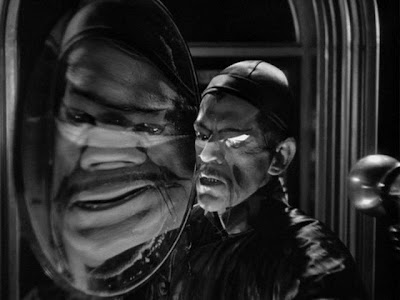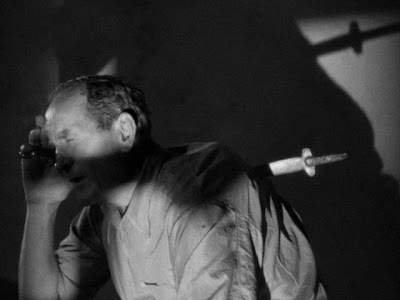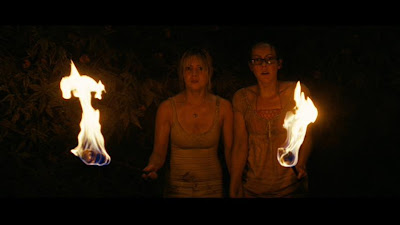
Here's a sneak peek at the last batch of horror films from my month long bender (which will fall far short of last year's number due to Toronto After Dark switching back to October):
The Deaths Of Ian Stone (2007 - Dario Piana) - Though I haven't seen many of the "8 Films To Die For" series (otherwise known as the "After Dark Horrorfest" which shows its independent films over an eight day span in nationwide theatres), I haven't heard a whole lot of positive response to any of the films even though last year's fest was the fifth one. However, the concept for "The Deaths Of Ian Stone" sounded too good to pass up: the titular character dies every night only to wake up in a completely different life. Promising stuff that could go one of any number of directions. Unfortunately it chose one that abandons its premise early on for life sucking ghostly monsters that can take human form. Worse than that though, its main character is just simply unlikeable. Even worse, he's just boring. As is the set of CGI-heavy effects of people turning into these black death spirit thingies. When he suddenly wakes up in a new life, Ian Stone has no recollection of his previous one so it just changes the situations within which this bland unsympathetic character exists. How exciting is that? Whatever rules the story had are shuffled to the side and it becomes generic in its rush to redeem Stone. If this is representative of the "8 Films to Die For" series, I can see why I haven't seen overwhelming response to it (though you'll see shortly, it isn't completely representative).





The Mask Of Fu Manchu (1932 - Charles Brabin) - Now here's an interesting artifact of the early 30s...Filled with great set design, interesting shot selections and a whole lot more torture than you might expect, the film also engages in some of the worst casual racism that side of "Breakfast At Tiffany's". It's not just the indiscriminate references to "the yellow man" (after all, Fu Manchu throws it right back at them with his hopes to eradicate "the white man"), but the thought that Asians think of nothing else but to rule the world. While the British wish only to find Genghis Khan's old artifacts to preserve them in a museum (even though they break into his old chambers with nary a thought to its preservation), Fu Manchu and his "hordes" want them so that they can convince the rest of Asia to follow them into world domination. When the Brits discover that this is the plan, they double their efforts to get there first. They do, but Fu Manchu has several devious plans up his sleeve to get them back. Possibly the worst moment of all was the patronizing comment from the wealthy English archaeologist to a Chinese waiter congratulating him for not aspiring to anything more than what he was and avoiding the fields of medicine, science and exploration. Perhaps I was reading the film wrong, but aside from some of the great visuals the story didn't have much else to hold it together, so I had to focus on something...





Private Parts (1972 - Paul Bartel) - This randomly selected title was quite the fine little surprise. Directed by Bartel (probably best known for "Eating Raoul"), it focuses on horrors of a more psychological nature - specifically those that arise from one's sexual urges. Young Cheryl is a runaway and ends up at her Aunt Martha's hotel looking to bum room and board for as long as she can. Her combination of naivete and curiosity about using her sex appeal is a concern to Martha (played by the great Lucille Benson - look her up, you'll know her) who will not stand for any of those "painted women" in her hotel. She also likes to frequent funerals in order to see the spirits of the dead rising heavenward. As much as Cheryl tells Martha not to worry, she can't help flirting with handymen until her attention focuses on George the photographer. He's a rather strange bird who has his own ideas about sex (confused as they may be) and one hell of an interesting photo studio. Cheryl works herself into rather dangerous predicaments while Martha attempts to keep her building pure. Battle lines become drawn and the final confrontation gets set. Like many of the horror films from the 70s, though, the curve balls are always ready to be thrown. Not just at the end either - you never quite know where things are headed at any point in the story. Bartel does a great job of pacing things out and keeping you always a bit off centre. If the acting is slightly dodgy at times, it's never overly distracting and doesn't take away from one of the more interesting horrors of the early 70s.






The Abandoned (2006 - Nacho Cerda) - While at the Toronto After Dark festival this year, the title of this film came up a couple of times - mostly due to the fact that one of its writers (Karim Hussain) was quite involved in the anthology "The Theatre Bizarre" that played the fest. By sheer coincidence (or was it...), I happened to stumble across the DVD of it at a charity sale in our office building a few days after hearing about its underrated status. So I snagged it for a couple of bucks and tossed it in the player. It was only then that I discovered that it was another of the "8 Films To Die For" series (though from a different year than the aforementioned "The Deaths Of Ian Stone"). The disillusionment set in, but I decided to press forward. Fortunately, it didn't take long to assuage my nervousness. First, it's a gorgeous looking film whose predominant greens and blues still cover a broad spectrum. Secondly, it is creepy as all get out. It centres around Marie - a 40-ish successful business woman who has returned to Russia to learn more of her roots after being abandoned by her parents as a baby. She travels to the old house of her parents and finds that not only can she not leave, but that her twin brother has also come to the same spot. As they encounter ghostly presences of themselves and piece together what happened years ago, they wonder if they have been summoned back in order to be finished off in the manner they should have been years ago. Even though there are few characters here, it is highly effective in pulling you deeper into Marie's predicament and dreading each new entry into a darkly lit place with a flashlight. After remembering that the "8 Films To Die For" also ran "Reincarnation" (the terrific film by "Ju-On: The Grudge" director Takashi Shimizu) and discovering that "The Broken" (a rather spiffy little thriller by Sean Ellis) was also part of it, I may just be turned around on the idea. But then I think of "The Deaths Of Ian Stone" and I reconsider all over again...








































